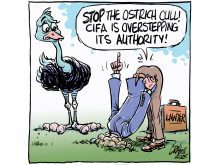CONSULTANT and former journalist Hugh Maynard claims to be frustrated by the attention focused on his recent suggestion of a tax on food.
It was just one suggestion of many in a 35-page discussion paper prepared for the Agricultural Institute of Canada, he complained last week during the AIC meeting when yet another question was asked about the controversial proposal.
“When it was written, I never dreamed it would get the attention it did,” said Maynard. In fact, the proposal hijacked most of the public discussion, drowning proposals for research, rural-oriented immigration, a new national food agency and support for sustainable farming practices in a sea of opinion and criticism of the taxing idea.
Read Also

Rural communities can be a fishbowl for politicians, reporter
Western Producer reporter draws comparisons between urban and rural journalism and governance
Maynard was featured on radio talk shows across the country.
On one Calgary call-in, the first irate question was: “Are you a Liberal?”
He should not have been surprised. It was predictable, even orchestrated by the AIC to drum up interest in the report.
And therein lies a lesson for the broader farm community and how it tries to communicate to the general and consuming public – be cautious in the way the main message is packaged or it may turn into an unwanted label rather than the hoped for positive impression.
For example, use of the perennial farm income crisis as a farm lobby message aimed at winning public sympathy for more aid could just as easily become a message to consumers and taxpayers that farming is financially unsustainable. That interpretation of the message would diminish rather than increase public sympathy. In a world of information overload, message consumers have little time to reflect on nuance or subtlety.
Be careful of the message.
So let’s return to Maynard’s dismay with the public fixation on the food tax balloon.
It was destined to capture attention simply because a tax increase suggestion flies in the face of the tax-cutting mood. Add to that the fact that expansion of the unpopular Goods and Services Tax was one of the suggested ways of collecting money and the proposal was guaranteed to get attention.
But rather than letting the natural process of controversial ideas rising to the top of the news pile take its course, the AIC set out to make sure it happened.
In late October, reporters received a News release
news teaser about the coming report and a chance to interview Maynard and AIC officials for an advance story.
The notice began: “Applying the seven percent federal GST or a comparable levy to groceries to help farmers transition to sustainable practices … (is one of) several major recommendations in a landmark discussion paper on achieving sustainable agriculture.”
A later News release
news featured the tax idea in the headline.
So, reporters were alerted to a controversial angle and the tone of questions was inevitable. Reporter Maynard could not have been surprised, even if consultant Maynard was.
It was a good illustration of what he calls “the law of unintended consequences.”
Farm lobbyists take note. In crafting a message aimed at drawing attention to the sector, be careful it does not focus attention where you would rather the light did not shine.
You control the message. Interpretation is the receiver’s prerogative.














